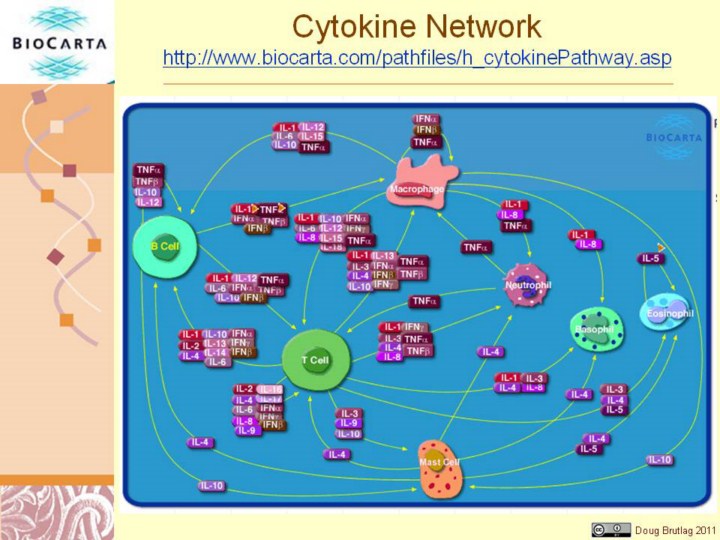| front |1 |2 |3 |4 |5 |6 |7 |8 |9 |10 |11 |12 |13 |14 |15 |16 |17 |18 |19 |20 |21 |22 |23 |24 |25 |26 |27 |28 |29 |30 |31 |32 |33 |34 |35 |36 |37 |38 |39 |40 |41 |42 |43 |44 |45 |review |
 |
http://www.biocarta.com/pathfiles/h_cytokinePathway.asp Several different cell types coordinate their efforts as part of the immune system, including B cells, T cells, macrophages, neutrophils, basophils and eosinophils. Each of these cell types has a distinct role in the immune system, and communicates with other immune cells using secreted factors called cytokines, including interleukins, TNF, and the interferons. Macrophages phagocytose foreign bodies and are antigen-presenting cells, using cytokines to stimulate specific antigen dependent responses by B and T cells and non-specific responses by other cell types. T cells secrete a variety of factors to coordinate and stimulate immune responses to specific antigen, such as the role of helper T cells in B cell activation in response to antigen. The proliferation and activation of eosinophils, neutrophils and basophils respond to cytokines as well. Cytokine communication is often local, within a tissue or between cells in close proximity. Each of the cytokines is secreted by one set of cells and provokes a response in another target set of cells, often including the cell that secretes the cytokine. Some cytokines, like IL-1, interferons and TNF, stimulate a broad inflammatory response in response to infection or injury. Other cytokines have more specific functions such the following examples. IL-2 stimulates the proliferation and activation of B and T cells. IL-4 plays a role in the differentiation of Th2 cells, in allergic responses, and in the switching of antibody types. IL-5 stimulates the production and maturation of eosinophils during inflammation. IL-8 is a chemokine, a chemotactic factor that attracts neutrophils, basophils and T cells to sites of inflammation. IL-12 and IL-18 are involved in helper T cell differentiation. IL-10 apparently acts to repress secretion of proinflammatory cytokines. The complex interplay of these different cytokine functions with immune cells is essential for correct immune function. |